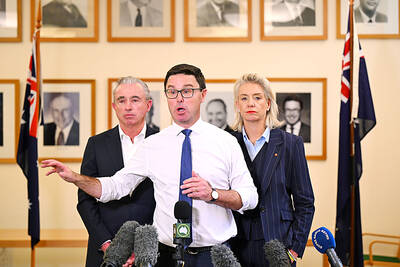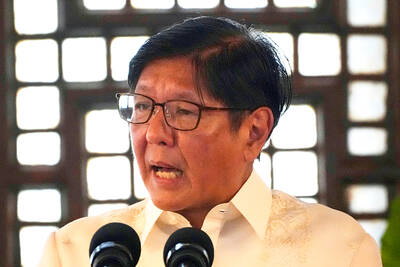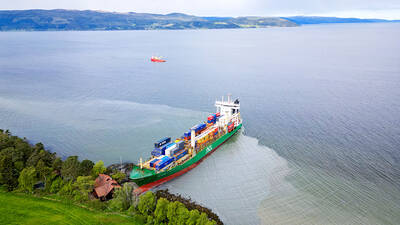US President George W. Bush on Wednesday cited a teaching hospital in Najaf as perhaps the top example of a successful rebuilding project in Iraq. Since the US-led attack against local militias leveled large portions of Najaf in August last year, however, the hospital has been most notable as a place where claims of success have fallen far short of reality.
During two visits to the hospital by reporters for the New York Times over the past year, the most recent in late summer, work on refurbishing it had been limited to largely cosmetic work like new ceilings and lighting and fresh paint. Critical medical equipment was missing and the upper floors remained a chaotic mess.
Numerous Iraqis at the site said the hospital had not been ruined by the militia that occupied it during last year's fighting, but instead by looters who entered after the US military left it unguarded after the battle.
US officials in charge of the project said US$2 million had been spent on the first phase of a planned two-phase, US$12 million renovation. So it is possible that work on the second phase has addressed some of the problems at the site.
While Bush cited the modest security improvements in Najaf, 145km south of Baghdad, and in the northern city of Mosul, he did not point out the often highly sectarian nature of local security forces that now patrol the cities.
Only last Sunday, Ayad Allawi, the former Iraqi prime minister who asked the US military to roust the militia from Najaf in 2003, was pelted with sticks and stones during his visit to the Imam Ali mosque in Najaf. Local security forces did nothing to stop the attack, almost certainly because they, like the mob outside the mosque, were loyal to the rebellious Shiite cleric Muqtada al-Sadr. It was al-Sadr's militia that the US battled in Najaf last year.
The hospital, named after al-Sadr's father, is an example of the slow pace of rebuilding. Wayne White, a former State Department official whose responsibilities included Iraq from 2003 to this year, and who is now at the Middle East Institute, a research organization, said the US mission in Iraq was often undermined by that slow pace.
"Not only does it run far behind Iraqi expectations, but in some areas we have not even recovered to what Iraq was before the invasion," White said.
He noted that some industries, including those involving metals and chemical production, still had not recovered from the invasion and the aftermath of looting, either.
A major problem with assessing the progress in Iraq is that it is too dangerous to allow visitors to visit the projects freely, said Rick Barton of the Center for Strategic and International Studies in Washington.
"I bet if we could get around and see these places that they would not be the story that he's telling," he said.
"And I think he'd be shocked to see the story he's being fed," he added.
Not all the accounts that Bush offered of reconstruction were positive. He conceded problems with "the infiltration of militia groups into some Iraqi security forces, especially the Iraqi police." And he did not assert that all had gone smoothly with the rebuilding effort.
"Like most of Iraq, the reconstruction in Najaf has proceeded with fits and starts since liberation -- it's been uneven," Bush said.
Visits to the cities Bush highlighted suggest that residents in Najaf feel safer and that Mosul's police force is more effective than when it collapsed in the face of the insurgency late last year. But the improvements have often produced little more than an assurance that the police, who still must be heavily backed by US firepower, will not flee in the face of an attack.
In Mosul, too, the starkly sectarian nature of the security forces is evident, as the largely Sunni police are sharply at odds with the Kurd-dominated northern Iraqi army.
Rebuilding in Mosul's extremely dangerous neighborhoods is a difficult proposition.

BACKLASH: The National Party quit its decades-long partnership with the Liberal Party after their election loss to center-left Labor, which won a historic third term Australia’s National Party has split from its conservative coalition partner of more than 60 years, the Liberal Party, citing policy differences over renewable energy and after a resounding loss at a national election this month. “Its time to have a break,” Nationals leader David Littleproud told reporters yesterday. The split shows the pressure on Australia’s conservative parties after Prime Minister Anthony Albanese’s center-left Labor party won a historic second term in the May 3 election, powered by a voter backlash against US President Donald Trump’s policies. Under the long-standing partnership in state and federal politics, the Liberal and National coalition had shared power

NO EXCUSES: Marcos said his administration was acting on voters’ demands, but an academic said the move was emotionally motivated after a poor midterm showing Philippine President Ferdinand Marcos Jr yesterday sought the resignation of all his Cabinet secretaries, in a move seen as an attempt to reset the political agenda and assert his authority over the second half of his single six-year term. The order came after the president’s allies failed to win a majority of Senate seats contested in the 12 polls on Monday last week, leaving Marcos facing a divided political and legislative landscape that could thwart his attempts to have an ally succeed him in 2028. “He’s talking to the people, trying to salvage whatever political capital he has left. I think it’s

CONTROVERSY: During the performance of Israel’s entrant Yuval Raphael’s song ‘New Day Will Rise,’ loud whistles were heard and two people tried to get on stage Austria’s JJ yesterday won the Eurovision Song Contest, with his operatic song Wasted Love triumphing at the world’s biggest live music television event. After votes from national juries around Europe and viewers from across the continent and beyond, JJ gave Austria its first victory since bearded drag performer Conchita Wurst’s 2014 triumph. After the nail-biting drama as the votes were revealed running into yesterday morning, Austria finished with 436 points, ahead of Israel — whose participation drew protests — on 357 and Estonia on 356. “Thank you to you, Europe, for making my dreams come true,” 24-year-old countertenor JJ, whose

UNSCHEDULED VISIT: ‘It’s a very bulky new neighbor, but it will soon go away,’ said Johan Helberg of the 135m container ship that run aground near his house A man in Norway awoke early on Thursday to discover a huge container ship had run aground a stone’s throw from his fjord-side house — and he had slept through the commotion. For an as-yet unknown reason, the 135m NCL Salten sailed up onto shore just meters from Johan Helberg’s house in a fjord near Trondheim in central Norway. Helberg only discovered the unexpected visitor when a panicked neighbor who had rung his doorbell repeatedly to no avail gave up and called him on the phone. “The doorbell rang at a time of day when I don’t like to open,” Helberg told television